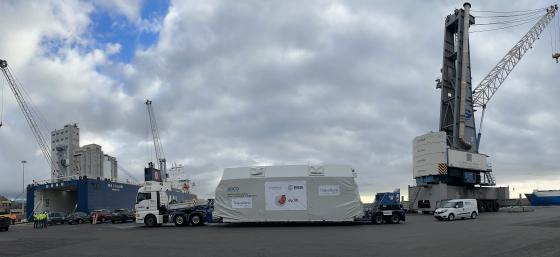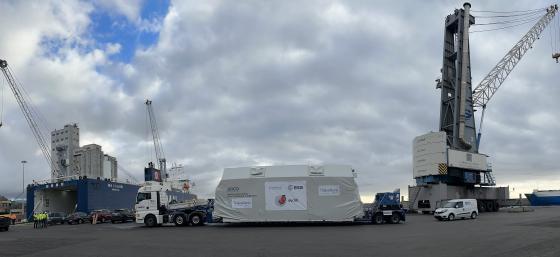The journey to the launch pad of the European Euclid satellite begins, on the trail of enegy and dark matter with Italy's key contribution

The European Space Agency's (ESA) Euclid satellite has begun its journey from the port of Savona. Next stop is the Cape Canaveral launch pad from where it will take off next July to position itself about 1.5 million kilometers from Earth, from where it will make a 3-D map of the location of billions of galaxies, to study dark matter and dark energy, which make up about 96 percent of the contents of the Universe, but whose nature we do not yet know.
Italy, through the scientific and financial contribution of the Italian Space Agency (ASI), plays an important role in Euclid, having participated from the beginning in the design and construction of the mission's instruments and being responsible for coordinating the preliminary analysis of the huge amount of data on the ground (Science Ground Segment). The scientific institutes involved in the construction of the instruments and the scientific activities in preparation for the mission are the National Institute of Astrophysics (INAF), the National Institute of Nuclear Physics (INFN), the University of Bologna, the University of Milan, the University of Genoa, the University of Roma Tre, the University of Ferrara, the University of Trieste, the International School for Advanced Studies (SISSA) in Trieste, and the Centro di Ateneo di Studi e Attività Spaziali in Padua. Also of particular importance is the contribution of the Italian space industries, which were involved in the forefront of all phases of Euclid's realization. These include Thales Alenia Space, lead company for the construction of the satellite and its service module, and responsible for its transfer to Cape Canaveral, OHB Italia of Milan, SAB Aerospace S.r.L. of Benevento and TEMIS S.r.L. of Milan, and, for the Italian Science Data Center, ALTEC of Turin.
Euclid is a European mission, built and operated by ESA, with contributions from NASA. Selected by ESA in 2011, it was formally adopted into the agency's science program in 2012. The Euclid Consortium, consisting of more than 2,000 scientists from 300 institutes in 13 European countries, and the United States, Canada and Japan, provided the scientific instruments and analysis of scientific data.
To date, cosmological studies confirm that the universe is expanding at an accelerated rate, and one of Euclid's goals will be to understand what the nature and properties of dark energy, the source responsible for this acceleration and as yet unknown, are. Dark energy alone accounts for about 70 percent of the current energy content of the cosmos. Together with dark matter, which does not emit light but whose presence can be inferred through gravitational interaction with ordinary matter, dark energy controls the past, present and future evolution of the universe. Euclid's observations will thus explore how the universe has evolved over the past ten billion years, answering fundamental questions about how gravity works, the physics of the early universe, and the initial conditions from which the cosmic structures we observe today originated.
The Euclid satellite, which will be put into orbit on a Space X Falcon 9 rocket, consists of a 1.2-m diameter telescope and is equipped with two scientific instruments capable of making complementary observations: a 610-megapixel camera operating in the visible wavelengths (VIS - VISibile imager) and a near-infrared spectrometer and photometer (NISP - Near Infrared Spectrometer and Photometer). The two instruments will make it possible, respectively, to measure with high precision the distribution of both ordinary and dark matter, testing the equations governing the evolution of the universe and the effects of gravity on a very large scale. These measurements will also have a great impact on particle physics, particularly in understanding one of the most elusive particles in the universe, the neutrino.


